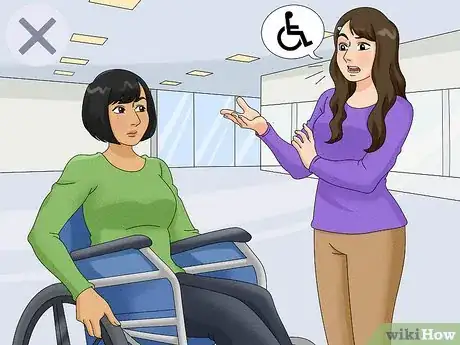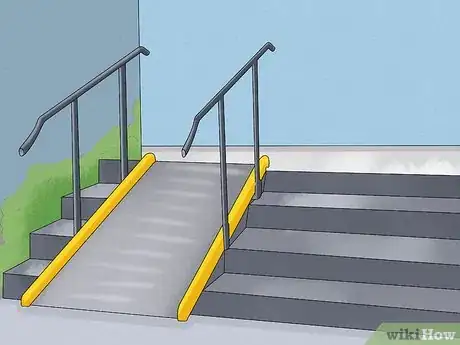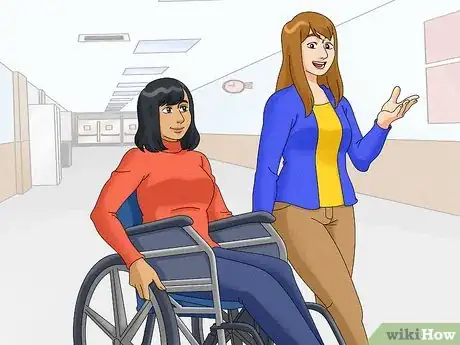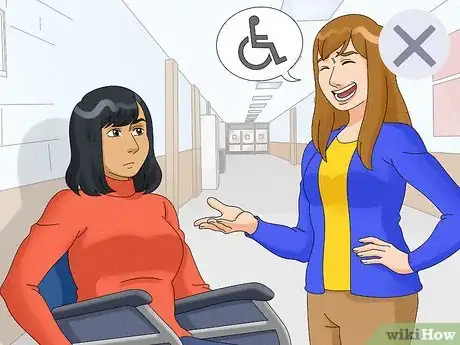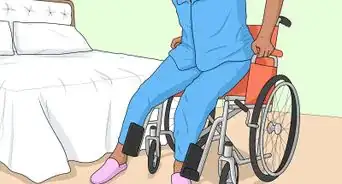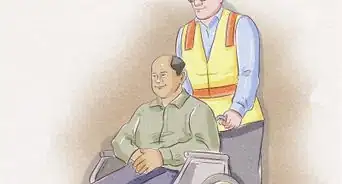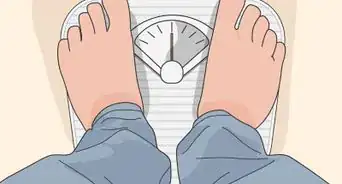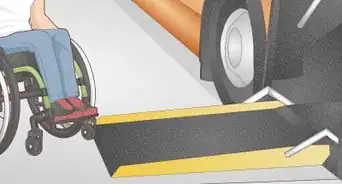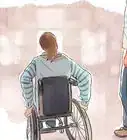This article was co-authored by Paul Chernyak, LPC. Paul Chernyak is a Licensed Professional Counselor in Chicago. He graduated from the American School of Professional Psychology in 2011.
wikiHow marks an article as reader-approved once it receives enough positive feedback. In this case, 100% of readers who voted found the article helpful, earning it our reader-approved status.
This article has been viewed 261,115 times.
People use wheelchairs for many different reasons. Wheelchairs enable freedom of mobility, like a car or a bicycle. If you're interacting with a wheelchair user for the first time, it can be difficult to know how to act. You don't want to accidentally offend someone, but at the same time, you want to be helpful and understanding. The most important thing to remember is people who use wheelchairs are really no different from you.
Steps
Being Respectful
-
1Avoid making presumptions about others' abilities. Being in a wheelchair does not mean the person is paralyzed or incapable of taking a few steps. Some people only use wheelchairs because they cannot stand for extended periods, or have a walking restriction problem. Often, people with heart conditions will use wheelchairs to avoid overexertion. If you are curious about why a person is using a wheelchair, it's better to ask than to assume. Consider adding a qualifier to the beginning of the question, so the person can easily decline if they feel uncomfortable. For example, "Do you mind my asking why you use a wheelchair?"
- Only ask a wheelchair user why they use a wheelchair after you've become familiar. This question is not appropriate from strangers.
-
2Speak directly to a person using a wheelchair. If a person using a wheelchair is accompanied by someone else, involve that person in the conversation also, but not in place of the person using the wheelchair. For example, do not direct questions about the person using the wheelchair to the person accompanying them.
- When in a long conversation with someone in a chair, sit down. It is very tiring -- even painful -- for a person in a wheelchair to have to stare up at you.[1]
Advertisement -
3Ask permission before touching the person or their wheelchair. Patting or leaning on the chair may be interpreted as disrespectful. The person may be using a wheelchair because of an injury, so your touch may be painful in addition to patronizing. Equally, do not touch the person in any way.
- Treat a wheelchair as an extension of a person's body. If you wouldn't put your hand on that person's shoulder, then don't put your hand on their wheelchair unnecessarily. Always respect a wheelchair user's personal space.[2]
Being Considerate
-
1Understand the difficulty of navigating a wheelchair in public when accompanying a person who uses a wheelchair. Locate accessibility ramps. They are usually located to the sides of doors or near restrooms, stairs, and elevators. When embarking down a path with multiple obstacles, ask, "What's the easiest way for you to do this?" Listen to and follow their instructions carefully.[3]
- If you are hosting an event, make sure it is accessible. Check the venue for barriers to the building's entrance. Make sure aisles and corridors are wide enough to maneuver a wheelchair. Bathrooms should be large enough to turn the chair around, and a handrail is needed. If the event is outdoors, then the ground or surfacing should allow a wheelchair to move easily over it. Gravel, sand, soft or very uneven surfaces can present a challenge.
-
2Be considerate when using public spaces. Certain public areas are designated for wheelchair use. Specific stalls in restrooms, parking spaces, and school desks are designated wheelchair accessible. Do not use these spaces unless you are accompanying a person who uses a wheelchair. You have the option to use all of the other stalls, parking spots, and desks, but people who use wheelchairs are often limited only to those designated wheelchair accessible.
- When shopping, be aware of scooter/wheelchair users and try to keep to one side or the other of an aisle. Share the aisle; walk as you would drive.
- When parking, avoid parking beside a van with a handicap license plate that appears to be away from other vehicles. The handicap van occupant may need the empty space next to the van to deploy a ramp when wheelchair user returns to the vehicle. Not all designated handicap parking spaces have sufficient space beside them to accommodate the ramp, so sometimes it is necessary for ramp-equipped vans to park far away from other cars to obtain the necessary space.
-
3Offer, but don't assume a person using a wheelchair wants help. If you see a situation where a wheelchair user could use your help, ask first. Don't be offended if a person declines; they are probably just very independent. [4] For example, if you see a person in a wheelchair approaching an entrance, you can ask, "Would you like me to get the door for you?" If you see a person using a wheelchair struggling up a steep incline, you might ask "Would you like me to help you up the hill?"
- Never move a person's wheelchair without permission. They may have had it positioned to transfer to and from the chair easily.
Being Polite
-
1When you first encounter a person using a wheelchair, shake hands, just as you would greeting anybody else. A handshake will establish a physical connection and diminish psychological barriers to emotional connection.[5] Even in cases where the person has a prosthetic limb, it is generally acceptable to shake hands.
- If the person is not able or does not wish to shake your hand, they will likely decline politely. Don't take offence, the rejection most likely is about concern regarding the physical act and has nothing to do with you.
-
2Converse casually, as you would with any other individual. Don't edit your word choice to avoid references to running or walking. Attempts to avoid common phrases like "running late" will likely only make the conversation awkward. Most people in wheelchairs do not recognize such common phrases as offensive.
- As in any conversation, if the person indicates they would prefer you avoided particular phrases, it is polite to honor the request.
-
3Avoid making comments or jokes about the person's wheelchair. People in wheelchairs have usually shouldered a fair amount of teasing. No matter how good-natured, the jokes can become annoying. These remarks only serve to draw attention away from the person and redirect it to the wheelchair.
- If the person makes jokes about their chair, it may be appropriate to join the banter, but never initiate it.
Warnings
- Since the wheelchair, much like glasses, is an extension of a person, it should be treated as such. Do not touch it, or attempt to push it, unless specifically given permission to do so.⧼thumbs_response⧽
- Referring to a wheelchair user as anything other than a wheelchair user can sound rude or condescending.⧼thumbs_response⧽
- If you do not know the wheelchair user personally, don't ask why they are in a wheelchair. This may be interpreted as a rude and insensitive gesture. However, if you are getting to know someone who is in a wheelchair, don't be afraid to ask at an appropriate time.⧼thumbs_response⧽
- Do not classify or think of people who use wheelchairs as invalids or sick. Many wheelchair users are in very good health, so this is inaccurate, in addition to being rude.⧼thumbs_response⧽
